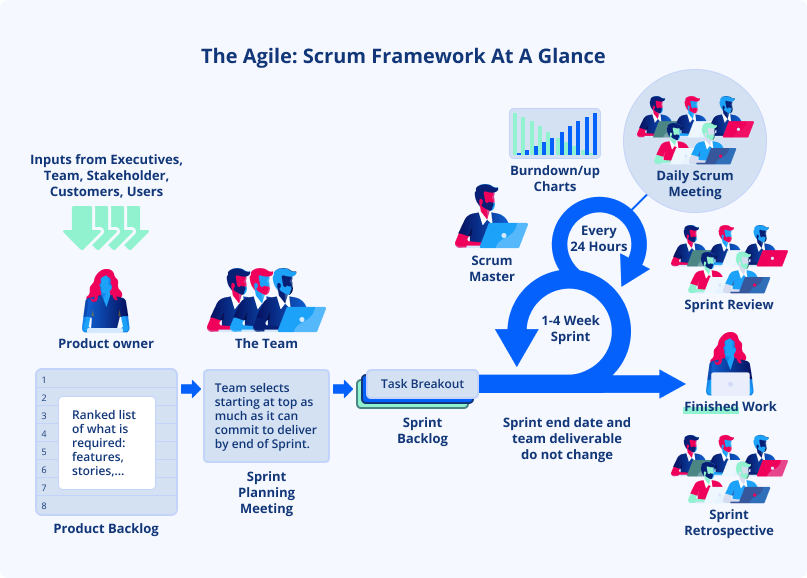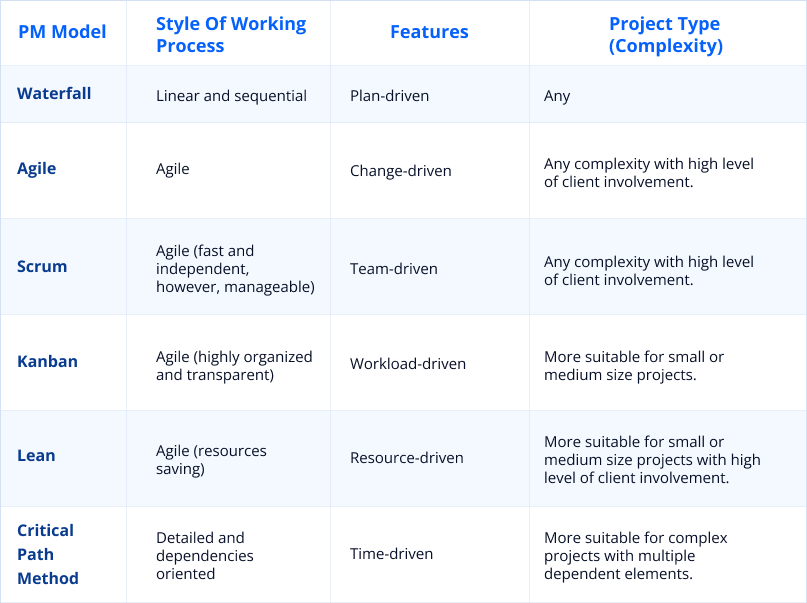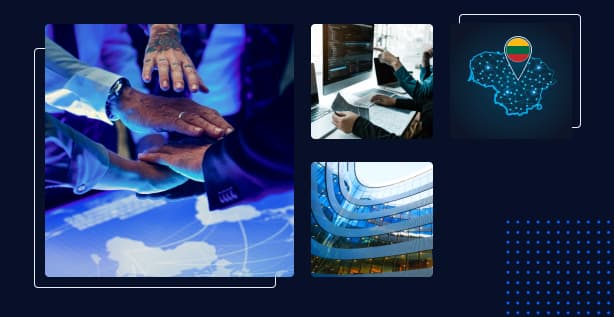Project management methodologies for software development – a set of principles, tools, and methods leveraged to manage software development teams.
Project management methodologies help teams to plan, coordinate, and control the fulfillment of project tasks.
As per Finances Online data, 77% of high-performing projects are developed leveraging various project management models. We’ll focus on several most popular methodologies you might consider applying while working with your dedicated development team.
Target audience for this article are technical and non-technical founders of software startups, or maybe your company already has a team of developers, and you need to plan the development process. The goal is to understand what methodology is the best match for you and how to apply it when working with a dedicated team.
Waterfall development methodology
The essence of Waterfall methodology
Waterfall is a linear approach to project management. All requirements are elicited at the beginning of the project and then a consistent implementation plan is created. In the Waterfall model, transition from previous to sequential project phase runs smoothly like a waterfall.
Basic Waterfall principles
1. Sequential project structure. The work of the dedicated team is divided into strictly sequential stages. Each stage focuses on the end goal defined at the beginning. The previous task must be completed before the next task starts: stage 2 depends on 1, 3 on 2, and so on.
2. Low client involvement rate. Most likely, your participation in the work on the project will be minimal: project status discussion and coordination of details. Then a dedicated team implements the project as per approved requirements on their side, and you only accept the work when done.
3. Solid project documentation. The Waterfall methodology means through discussion of project details at the initial stage. These details include:
- Results obtained when the project is accomplished.
- Dedicated team skills required to complete the project.
- Project timeline.
- Understanding of how the team plans to implement the project from inception to completion.
All these details are documented and implemented throughout the entire project life cycle.
Perfect match for a client when:
- Project requirements are clear and fixed.
- Resources to manage the development team are limited.
- Detailed documentation covering all the development processes is required.
Not the best option to consider if:
- Ultimate project involvement is required.
- You plan to make a lot of changes and modifications in project requirements.
Agile development methodology
The essence of Agile methodology
Agile methodology is featured by an agile approach to software development. Applying this methodology means creation of requirements and solutions in the process of development.
Basic Agile principles
1. Customer satisfaction through regular software development. The development team doesn’t aim at implementation of all the features at once. A working application with limited functionality is the result of initial development iterations. Corrections and additional features are additionally implemented over time.
2. Making project changes to improve competitive advantage. The market is continuously changing along with competition and end user requirements. Product improvement is an absolute must to keep up with the competition.
3. New software is released on a regular basis – every couple of weeks/months. Short time intervals are preferable. Continuous delivery makes the process of introducing new functions quick and reliable. Bug fixing takes less time should issues occur.
4. Day to day communication with a dedicated development team throughout the whole project cycle. The Product Owner being actively involved in work coordination stimulates formation of the product vision in terms of necessary features, their priority, etc. It is vital for the team to understand what should be achieved for both the coming release and the product in general.
5. Keeping a permanent and steady project development cadence. It is important to avoid team overload with assignments: every new idea is estimated and planned for the following development iterations. The scope of work for the current iteration remains unchanged, which allows the product to get to the end user faster.
Perfect match for a client when:
- A project needs fast changes or requirements can change in the future.
- You require or want to be involved at every development stage.
- A project has no strict and fixed timeline, budget, and requirements.
Not the best option to consider if:
- The project should be finalized by a certain date.
- You have no chance to coordinate the team development team work due to lack of time, skills, or wishes.
Scrum development methodology
The essence of Scrum methodology
Scrum is one of the Agile methodologies’ variety. It observes the values and principles of Agile, however includes additional definitions and specifications.
The main goal of Scrum is to satisfy the needs of the client through communication, collective responsibility and continuous progress. Development begins with a general idea of what should be done. The product backlog containing the list of features and tasks is created and prioritized.
Basic Scrum principles
1. Backlog management. Product backlog is the list of prioritized tasks for the development team. Most important tasks are placed at the top of the backlog so that a development team has a sense of what should be implemented first. Backlog items are detailed and elaborated in collaboration with the Product Owner, Scrum Master (a person observing that the Scrum rules are followed) and the development team.
2. Sprint planning. A development team headed by the Scrum master plans the sprint scope that should be accomplished during the next sprint. Sprint is a fixed time interval (more often 2 to 4 weeks long) when the development team implements the agreed amount of work. Specific tasks from the product backlog are added to the sprint.
3. Sprint backlog. Sprint backlog is presented by the atomic assignments (stories, bugs, tasks) that are to be done within the current sprint. A sprint planning session is organized before every sprint where the team picks the tasks to be done within the sprint scope.
4. Sprint. Sprint is a time frame given to a team to fulfill the predefined set of tasks. Daily Scrum is a daily event where every team member answers three questions: «What did I do yesterday that helped the Development Team meet the Sprint Goal?», «What will I do today to help the Development Team meet the Sprint Goal?», «Do I see any impediment that prevents me or the Development Team from meeting the Sprint Goal?». The goal of the Daily Scrum is to define work status and progress.
5. Sprint Review and Sprint Retrospective. Sprint Review and Sprint Retrospective aim at:
- Evaluate the efficiency of the team in the last sprint.
- Forecast expected efficiency for the next sprint.
- Reveal existing issues.
- Assessment of the probability of completion of all necessary work on the product, etc.
The goal is to create conditions when a team can focus on all the successes and failures, and what can be improved for the next sprint.
Perfect match for a client when:
- You can be fully involved in the process.
- Your dedicated team is experienced and self organized.
- You want to have room for project requirements changes.
Not the best option to consider if:
- You can’t be involved in the project on a regular basis.
- You have clear deadlines for project implementation.
- An experienced Scrum master or a person who can replace this role is unavailable.
- The team is unfamiliar with this methodology and thus has no experience.
Kanban development methodology
The essence of Kanban methodology
Kanban is another kind of Agile methodology. Kanban focuses on visualizing the entire project on boards, so that all processes are in the team’s view. A typical Kanban board consists of one or more multiple columns to depict the workflow process.
Basic Kanban principles
1. Visualization of work process. Visualize your work on a board using cards to present your work step by step. The simplest Kanban board would include three columns: “To-Do”, “In Progress”, and “Done”. Arrange task cards in columns based on the status of the workflow. This allows the entire team to view current work, completed tasks, and those that are to be done.
2. Limit work in progress. Set a limit on the number of tasks that can be worked on at a time per column. This ensures that tasks move across the board smoothly and without blockages. The dedicated development team can start working on them only when the column has room for another task.
3. Focus on workflow. Make sure you observe the flow of tasks. Workflow should run smoothly without interruptions. Select several task flow metrics to track and analyze work. For example, you can keep track of how many tasks go through the board a week, and which tasks haven’t been addressed yet.
Perfect match for a client when:
- Your team is not open to big changes, and therefore the methodology should be easy to learn.
- Your goal is to visualize the project progress.
- You need planning flexibility when the team is focused on the current processes and the need to change priorities occurs.
Not the best option to consider if:
- The size of the team is quite big, making it challenging to see the full picture and track work.
- Long-term planning is the goal.
Lean development methodology
The essence of Lean methodology
Lean is a methodology focused on clients and their needs. If any action during the software development process does not improve the quality of the product, does not save the developer’s time, and does not bring profit to the client, it should be avoided as a waste.
- Processes making the product faster and better are subject to improvement.
- Processes slowing down work or reducing the quality of the product should be excluded.
Basic Lean principles
1. Identify value. Value is presented by a problem you are trying to address for a client. The part of the solution the client is ready to pay for in particular. Any other activity that does not add value to the final product is useless. This approach helps to define the process parts bringing no value and remove them. The methodology aims at elimination of the following processes:
- Written but unused code is a waste of time.
- Features not used by the target audience don’t bring value and are considered as wasted resources.
- Plans contain more tasks than will be actually accomplished.
- Ambiguous requirements.
- Ineffective communication.
- Quality issues. For instance, code quality should be observed from the very beginning. If code issues are found late in the project, a significant part of the code will have to be rewritten.
- Costs of the above-mentioned items.
2. Learning perfection. Software development is a continuous learning process: developers better understand the client’s needs, potential architecture solutions, testing strategies, etc.
3. Important decisions should be delayed as far as possible. Requirements are tested before coding. Make the most important decisions only having enough information about the decision.
For instance, complex architectural decision might require experimenting and therefore shouldn’t be made at an early initiative stage. Room for changes should be available as long as possible.
4. Fast implementation. Lean pays special attention to the short cycle, meaning reducing the time from a feature request to delivery. The reason behind this is that while a feature is in development, it does not bring any value to the customer, and the need may become obsolete within the long development cycle.
5. Quality built. The principle says that the code of a software product should be initially created according to all best practices and not postpone the elimination of code errors “until better times” or testing. For example, if a defect is discovered early in the development process, ongoing work should be stopped until the issue is fixed.
6. See the whole. Software development should consider the entire value creation chain from start to finish without suboptimization. Suboptimization is a drawback of any development process. The core of suboptimization is that clients or the development team usually focus on success in their particular activity, overlooking the success of other system elements. Every person involved in the project should know their roles and responsibilities from inception to the end. Thus, overall optimization enables Lean to increase the value and quality of the holistic product.
Perfect match for a client when:
- You can be involved in the project and often communicate with the team.
- You want to cut costs by removing unnecessary activities.
Not the best option to consider if:
- You plan to create a sophisticated system.
- You have no time for continuous communication with the team.
Critical Path Method
The essence of Critical Path Method
CPM is a method of discovering the most important tasks in a project and scheduling their work. Planning includes creating dependencies between tasks, their goals, progress of work, setting priorities, and managing deadlines.
Basic Critical Path Method principles
1. Prepare the list of all the tasks required for project finalization. Having a list of tasks can help to estimate the scope of work. It is essential to sort tasks in terms of their priority. Split the tasks into groups and determine the sequence of completion.
2. Determine dependencies between the tasks. Task dependencies definition is the process where a sequential work step is unavailable unless the previous one is completed. Clear understanding of what project tasks prevent the project from moving forward is vital. You can prioritize your most critical tasks and postpone lower priority tasks.
Dependencies not only reveal relationships between tasks, but also influence your resource management decisions. You can predict whether additional resources should be involved to complete the project.
3. Estimate time needed to accomplish every task. You can use the expertise of the dedicated team to estimate the time required to finalize the project tasks. The estimate will help to allocate time required for completion of priority tasks.
4. Create a chart. Once you have the list of tasks, timeline, and clear vision of dependencies, you can start drawing up the charts. The critical path analysis chart provides clear visualization. You can represent each task as an icon and then use the arrows to interlink-dependent tasks. You might find it useful to study the document providing detailed calculations required for the CPA.
Perfect match for a client when:
- You know what you want to achieve in the end.
- You have a large and complex project.
- There are a lot of dependencies in the project.
Not the best option to consider if:
- You don’t need something really complicated.
- You are uncertain about the project timeline.
How to choose the right project management methodology
Before deciding on a methodology, make a list of the main criteria making your choice meaningful:
- What is the ultimate goal of your project?
- What is the level of project complexity?
- What methodology is currently applied in your company?
- What is the desired/required level of your personal project involvement?
- Can you increase the project budget if needed?
- Do you have a clear timeline for product release?
- What size team do you need?
- Do you anticipate project changes as it progresses?
We created the chart below reflecting all the development methodologies listed in this article to help you make the final decision.

















